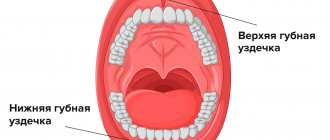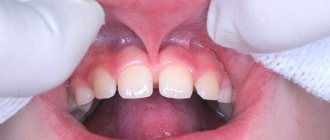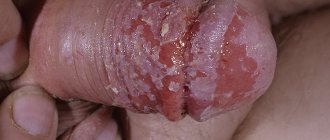Let's start with what a bridle is. When the upper lip is attached to the jaw bones, during the formation of the dentition, an “extra” fold of skin is formed - if you touch it with your tongue, it can be easily felt at the very base of the upper teeth from the outside.
In its normal state, the frenulum does not in any way affect the position of the teeth, the bite or the condition of the oral cavity. But a frenulum that is too short or, conversely, too large can directly affect the aesthetics and health of the dentition.
An untrimmed bridle can result in the following problems:
- Diastema
(a wide gap between the front teeth) when the upper incisors cannot meet closely due to a fold of skin.
- Additional load on the dental system.
- Speech therapy problems, diction disorders.
- Increased risk periodontal diseases
(a short frenulum “pulls back” the gum, causing the formation of a so-called gum pocket, in which plaque, bacterial deposits and tartar accumulate, which leads to gum inflammation).
As a rule, problems with the frenulum are detected in people already in childhood, and this is the most optimal period for plastic surgery of the frenulum of the upper lip. This is a simple and short operation, which in the future can eliminate the above problems.
Frenules in the oral cavity
When parents talk about the frenulum in the child’s mouth, most often they mean the frenulum of the baby’s tongue, which is quite natural. Problems arise more often precisely because of this oral frenulum: from improper attachment to the breast in the first days of life to speech impairment in the future.
Even dentists give the leading role and importance to this particular frenulum, but this does not mean that the remaining frenulums are unimportant and cannot provoke any pathology.
There are three frenulums in the child's mouth. A frenulum in the oral cavity is nothing more than a small strand of mucous membrane. But, despite this, the frenulum in the oral cavity is of great importance in the life of a child; the child’s nutrition, correct pronunciation of sounds, the condition of the mucous membranes, not to mention the child’s bite and facial aesthetics depend on their condition.
Dentists distinguish between the frenulum of the upper and lower lips and the frenulum of the tongue. Each of them has its own location and performs a number of functions. The frenulum of the lower lip connects the body of the lower jaw and the lower lip; normally, the frenulum is woven into the gum of the lower jaw below the level of the central incisors.
The frenulum of the upper jaw is located according to the same principle as the frenulum on the lower lip. This mucous cord also raises many questions and complaints from parents, since it is primarily associated with the formation of an aesthetic defect in the oral cavity - a gap between the teeth. And the last frenulum in the baby’s mouth is the lingual frenulum, which is woven into the tongue and sublingual space.
Symptoms of gum inflammation
According to statistics, more than 70% of people have experienced inflammation of the gums between their front teeth at least once in their lives. The main signs of the problem include:
- redness of the gingival papilla,
- swelling of soft tissues,
- bleeding gums,
- bad breath,
- accumulation of pus in the interdental space,
- discomfort when brushing teeth and eating.
If you notice any of these signs, you should consult your doctor. These symptoms can indicate either injury to the gums from hard food or bones, or the development of serious diseases.
Why are short bridles dangerous?
Short frenulum in the mouth can cause many unpleasant consequences. The first of them: the baby cannot attach to the breast correctly, so during feeding it expends a lot of effort, but at the same time receives a smaller volume of milk, and it is simply not enough to satiate. This is sometimes the reason for poor weight gain, but quite often mothers and doctors mistakenly look for the cause in a mythical lack of milk, or some disease, although, first of all, it is necessary to look into the oral cavity and assess the condition of the frenulum.
It is very important for parents to know and remember about this problem, because according to statistics, every 14th child has short frenulum in the oral cavity. If you notice this feature in time, then in the future you can avoid many problems and unpleasant consequences - disturbances in nutrition, speech, bite and, accordingly, facial aesthetics.
For the first time, doctors may notice a short frenulum in the baby’s mouth during the first examination, immediately after birth, and if the fact is confirmed, correction is carried out on the spot. This rule applies to a short frenulum of the tongue, but if the frenulum does not interfere with full natural feeding, the frenulum will not be trimmed in the maternity hospital. Symptoms of a short frenulum may appear later - the child may have difficulty pronouncing some sounds, in which case “treatment” will be carried out later, and, as a rule, in tandem with a speech therapist.
Upper lip frenulum
Even with a simple smile you can see the frenulum of the upper lip, but few people pay attention to it. During a routine examination, the doctor assesses its length; in order to assess the size of the frenulum at home, parents just need to move the baby’s upper lip, and it will become noticeable where exactly the frenulum is woven. In the event that the frenulum is woven between the two front incisors 5–8 mm higher, this is a normal option. If the frenulum is woven below this level, these are obvious symptoms of a shortened frenulum, but the final word always remains with the doctor.
A short frenulum on the upper lip can provoke a violation of the aesthetics of a smile when a gap is formed between the central incisors - a trema, a diastema. It is worth remembering that tremors can be physiological; this period is observed during the period of primary occlusion, when the child’s jaws are preparing for the change of primary teeth to permanent ones. In addition, trems can be pathological, which are formed as a result of some pathology. Treatment of this problem is most often carried out in tandem by a surgeon and an orthodontist.
A short frenulum in a child’s mouth can cause malocclusion, which is formed due to the constant tension of the mucous membrane on the upper jaw and bone tissue. As a result, the front incisors move forward. In addition, such pressure on the mucous membrane provokes inflammation of the mucous membrane - gingivitis. There is a loss of gums, as a result of which the necks of the teeth are exposed and the child develops hypersensitivity of the teeth, and all the conditions are created for the formation of cervical caries.
How does the correction happen?
Treatment of the problem is exclusively surgical, but with one big “BUT”. The frenulum on the upper lip can be corrected only after the eruption of the permanent central incisors, not earlier!!! In some cases, the doctor will recommend adjusting the oral frenulum at the time of the eruption of the permanent lateral incisors - in order to close the gaps between the teeth, such a correction can eliminate orthodontic treatment.
The reason for this ban is very simple. The fact is that during the growth of the jaws, the frenulum on the upper lip can self-correct. That is why there is no point in correcting the frenulum at an earlier age. The correction itself is carried out in a surgical room, under local anesthesia. There are no nerve endings in the mucous cord itself, and therefore the operation is painless; pain relief is necessary when suturing. The operation lasts no more than half an hour and ends with stitches. Thanks to the use of a laser, there is no need for stitches. But there is a certain condition that must be observed after excision of the frenulum: the little one must immediately be attached to the chest.
At what age is the procedure performed for children?
In children, pathologies of the lower lip frenulum can cause various negative medical and aesthetic consequences. Therefore, if a doctor finds a defect during a routine examination and recommends plastic surgery, it is better to take his advice.
Dentists believe that the best age for frenulum correction in children is from 5 to 8 years. It is during this period that temporary teeth are replaced with permanent ones, so it is important that the frenulum does not disrupt the correct development of the molar units.
If there are indications, plastic surgery of the lower lip frenulum can be performed in adolescents or adults. For infants, this operation is prescribed only if there are serious problems, for example, the inability to fully feed on breast milk.
Frenum of the lower lip
Dentists say that not all babies have a frenulum on the lower lip; it may be completely absent or forked. To study the length of the frenulum, the same technique is used as for studying the frenulum of the upper lip. Normally, the frenulum should be thin and attached in the middle of the body of the jaw. An important condition is that the frenulum of the lower lip must coincide with the center line between the incisors. If these conditions are not met, the bridle is short.
A short oral frenulum interferes with breastfeeding, as the baby cannot properly latch onto the mother's nipple. Fortunately, this situation is quite rare; the most typical manifestation of a short frenulum in the oral cavity is the presence of inflammatory gum diseases in the area of the lower incisors and malocclusion according to the same principle as in the upper jaw.
There are no age restrictions when excision of the mandibular frenulum; usually the mandibular frenulum is diagnosed and corrected at approximately the same time. The principle of the operation is similar to correction on the upper jaw.
Methods of lip frenuloplasty
Today, the following methods are used to correct the frenulum of the lower lip:
- Frenotomy (dissection of the frenulum). This technique is used when the frenulum is too narrow and is not attached to the edge of the alveolar ridge. The dissection occurs across the fold.
- Frenectomy (excision of the frenulum). The technique allows you to correct too large a frenulum width. The incision is made along the ridge.
- Frenuloplasty (displacement of the area of attachment of the frenulum).
When using the above methods, sutures are applied with special absorbable threads. The procedure lasts about 15 minutes under local anesthesia and does not cause discomfort.
Laser plastic surgery of the frenulum of the lower lip
Correction of the shape of the frenulum has recently been increasingly performed using a laser. The cost of laser therapy is higher than the price of plastic surgery with surgical instruments, but the procedure is easier to tolerate. The laser beam excises unnecessary tissue, sealing the edges of the wound. The advantage of laser technology for frenulum correction is that there is no need for sutures. The surgical intervention is not accompanied by bleeding, and the recovery period takes a short period of time.
Thus, we can highlight the following advantages of laser plastic surgery of the lower lip frenulum:
- Painless.
- No blood.
- Eliminating the risk of infection (the laser has an antiseptic effect).
- Reduced level of psychological discomfort.
- Fast recovery.
- No need for stitches.
Due to its safety and painlessness, laser plastic surgery is used in children. But adult patients often choose this particular correction technique.
Post-operative care
Complete tissue healing after the procedure occurs in one to two weeks. During this time, the following recommendations should be followed:
- Perform regular, thorough oral hygiene with products prescribed by a specialist.
- Avoid eating hot, hard and sour foods.
- Visit your doctor for a follow-up examination at the time prescribed by the specialist.
- Perform gymnastics to strengthen muscles.
If you follow the above recommendations, the recovery period will pass quickly and without complications.
Tongue frenulum
The most complex and insidious frenulum in a child's mouth. It is this frenulum that is able to regulate the movement of the tongue in the oral cavity. Normally, the frenulum is woven approximately in the middle of the tongue, and its length is approximately 8 mm. If the frenulum is attached almost to the tip of the tongue, this is a direct indication for correction.
After birth, the doctor must examine the baby’s oral cavity, which makes it possible to diagnose the pathology. If the frenulum is short, this can lead to difficulties in feeding, and correction is carried out in the maternity ward.
In some cases, the doctor may not notice a short frenulum, but when feeding, the child may experience symptoms that indirectly indicate pathology.
When feeding, the baby makes “smacking” sounds, often drops the breast and tries to rest - the feeding schedule changes, and the number of feedings increases. Babies may be capricious at the breast or even refuse, as a result the child does not gain weight well. Mothers often complain that babies bite their breasts because they cannot get their tongue between the gums and the mother’s nipple.
A short frenulum in the oral cavity can be diagnosed throughout life. In order to make sure once and for all that everything is in order in the child’s mouth, it is necessary to carry out a series of tests. Parents can also do this, although the doctor will most correctly conduct the tests.
The child should be asked to open his mouth and reach his tongue to the roof of his mouth. If the baby performs this operation without any difficulties, there is nothing to fear. But, if the child experiences unpleasant or painful sensations, or the baby is not able to reach the sky, this is an indication for a quick visit to the dentist. Parents should remember that such a test is informative only for children two to three years old.
Only a dentist or speech therapist can confirm shortening of the frenulum of the tongue in children of school and preschool age. Usually, an examination is prompted by a speech disorder in a child, when the child cannot pronounce a certain set of sounds - “r”, “sh”, “sch”, “zh”, “ch”, etc.
How does the correction happen?
There are features of correction depending on the age of the child. In the case of frenulum correction in newborns, which occurs in the maternity ward and with the obligatory presence of the mother, the frenulum is cut using special scissors or a laser, the latter is preferred. There are no nerve fibers in the frenulum itself, but there are many blood vessels. When using a laser, all blood capillaries are closed - there is no bleeding, and there is no need for stitches. A prerequisite is the presence of the mother during the procedure, since immediately after excision of the frenulum, the baby must be attached to the breast. It is at this time that the frenulum returns to normal and possible bleeding stops.
In the case of correction of the tongue frenulum in older children, both surgical and speech therapy treatment can be used. Everything will depend on its length and the age of the child, and on the consequences that this pathology provoked. Parents must clearly remember that the final verdict rests with the dentist, and not with the speech therapist, who can sometimes give false hopes for stretching the oral frenulum using various exercises.
It is the dentist who can assess the damage and clearly predict whether speech therapy treatment is suitable in each specific case. Quite often, dentists advise using complex treatment: surgical dissection of the oral frenulum and the use of speech therapy exercises - this combination gives excellent results.











